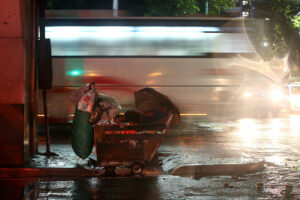“Shit! Shit!” an American friend blurted as he recoiled at the sight of small kids rummaging through garbage along a dingy street in Metro Manila one evening some years back. True, the homeless walk the streets even of the most advanced economies, but maybe the sight of children gives this social blight a particularly Third-World hue.
I could not let this issue pass with the end of the holidays (the Christmas season officially ran its course this Sunday).
One need not look far for signs that our relatively fast overall economic growth leaves many folks behind, with street beggars — many of them children — approaching one’s window at almost every major intersection.
A September 2023 study by the non-profit July Homes Foundation and Association Soeur Emmanuelle Philippines, Inc., cited Philippine Statistics Authority estimates that there were an estimated 4.5 million homeless individuals in the Philippines — including about 250,000 children, many of them engaged in begging, peddling, and jeepney “barking” — as of 2018, about two-thirds of them in Metro Manila.
I suppose far too many of us may have already been inured to that sight, even as it may still be difficult for some folks — especially for those on the lookout for small opportunities to help the underprivileged — to turn a blind eye to visibly malnourished kids on the street.
But the existence of groups capitalizing on this social issue (I recall a time when kids who approached my window gleefully pointed to an adult seated at a street corner happily nibbling on a morning snack, when I asked for their “handler”) begs the question of how to distinguish those truly in need from those mobilized to prey on the goodwill of pedestrians and motorists.
Not to mention the safety risks this issue presents those — both beggars and motorists — on the street. I shudder every time I see kids leaning unmindfully on the front grills of automobiles — too small to be noticed — as drivers wait for traffic lights to turn green.
Personally, I avoid giving cash to those kids (begging as their elders stay in plain view on sidewalks) and choose instead to give food to families collecting bottles, plastic containers, and cardboard boxes in a bid to earn their keep.
NOT MY DEPARTMENTUp to last year, government officials would just resort to reminding the public that it is unlawful to beg and to give to beggars, citing Presidential Decree No. 1563, or the Mendicacy Law of 1978, that was issued by then President Ferdinand E. Marcos, Sr.
But something has always been lacking.
When I decided two years ago to call a couple of government offices to alert them to a group of homeless families staying at a blind corner of a major road junction with a free right detour, their children darting to and from cars stopped at a traffic light even at night, I was given the runaround (“that is not under our jurisdiction, call…”) until I finally got to the city government concerned. Section 7 of PD 1563 mandates local governments to “provide socio-economic programs and establish operating units including reception and action centers, sheltered workshops, constitute homes and other facilities for mendicants” in coordination with the Department of Interior and Local Government. But when e-mails, landline calls, and Facebook messages went unanswered for a week, I decided — as a last resort — to just message the city mayor and, lo and behold, the families disappeared (to where, I do not know)… for about a week, that is.
Sadly, that experience left the impression that some bureaucrats manning departments and agencies tasked with addressing the problem of homelessness — at least some of those on the front line with the public — would rather be elsewhere than attending to concerned citizens taking the time and trouble to alert them to a situation (i.e., when there is more than the usual risk for beggars and pedestrians/motorists).
Which is why it is time for the government to step up its response, as part of a comprehensive anti-poverty drive.
To be sure, the government has undertaken a few initiatives to address the many causes of homelessness in major urban centers. Among others, it has been offering balik-probinsya assistance to those who wish to return to their home provinces. It is not clear how successful that tack has been, considering that major economic activities remain concentrated in key urban centers nationwide (Metro Manila alone contributes nearly a third to national output, while the National Capital Region, as well as Central Luzon and Calabarzon combined account for more than half). A government official once said that beggars could earn up to P1,000-P1,500 a day, if such an estimate were to be believed. Why return to home provinces if there are even less livelihood opportunities there?
NEW TACK?And so, I guess, the issuance of Executive Order (EO) No. 52 nearly a year ago on Jan. 18 represented a logical next step in addressing this social ill. EO 52 institutionalized the “Pag-abot” (Reaching Out) program of the Department of Social Welfare and Development (DSWD) which, in turn, kicked off in July 2023 to provide those “living and staying on the streets” in Metro Manila with interventions and opportunities to improve their socioeconomic conditions.
That EO outlined packages to be offered as financial support to cover the basic needs of beneficiaries while they are in transit from their current residence to a place of relocation, transport and relocation assistance, temporary shelter assistance pending processing of beneficiaries’ return to their home provinces or relocation sites, employment and livelihood assistance, as well as capacity-building support for local governments and communities.
It also recognized the need for close cross-department coordination and formed a committee led by the DSWD chief and consisting besides of the secretaries of the Interior and Local Government, Agriculture, Trade and Industry, Labor and Employment, Health, and Budget and Management; the chairperson of the Presidential Commission for the Urban Poor, the director general of the Technical Education and Skills Development Authority, the president/chief executive officer of the Small Business Corp., and the administrator of the Cooperative Development Authority.
Official data as of the first week of this month showed that the Pag-abot program had profiled 9,763 individuals and “reached out” to 4,348 of them. A drop in the bucket vs. the millions in Metro Manila alone, but — as with any other gargantuan task — you just gotta start somewhere. Drawing up a database of verified beneficiaries has been a good — and indispensable — beginning for this program.
NEXT STEPSBut what else?
To be sure, it’s about time that steps are taken to firm up cooperation and coordination across departments, agencies, and offices that cover various aspects of this issue.
Hopefully, however, that will mean better communication among them, including when it comes to addressing tips from concerned citizens. That includes establishing and informing the public of hotlines to call (working ones, ha?) in order to leave tips (I am sure there won’t be that many at the start anyway). The onus should not be on a concerned citizen to keep calling various offices until he/she finally contacts “the right” one.
Local governments should step up their involvement here. Metro Manila governments are among the richest in the country, and this issue ought to be among their priorities. The proliferation of the homeless on our streets is the clearest sign that not enough is being done to help them. Civil society groups, much less individuals, can do only so much with the few resources that we have. To start with, local governments could train and employ some of the homeless to beef up some basic services (e.g., more street sweepers or whatever else a locality needs more of). I am sure there is enough innovativeness in local government offices to draw up programs that make the homeless productive members of society. The DSWD, the Metro Manila Development Authority, and civil society could even recognize the most innovative programs in this regard, with the help of all the other departments and agencies in the interagency committee which EO 52 formed.
Relocation efforts should also be better planned, with livelihood opportunities and basic services (electricity, running water, access to elementary education, etc.) awaiting beneficiaries at the sites in order for those options to be more attractive to them (I can now imagine some politicos arguing that there is no money for this, since the homeless are not registered voters; don’t get me started…)
Finally, coordination and cooperation should extend to the private sector (i.e., CSR) and civil society (including religious) organizations with years — even decades — of continuous excellent service to the marginalized despite very limited resources. The government could draw up a database of groups with such track records. This is one rich source of not only goodwill and commitment, but also of solid experience and expertise which the government could tap to help it address this problem that stares us in the face every time we step out onto the street.
True: the issue of homelessness and informal settlements stems largely from the dismal failure of one government after another to support the development of enough economic opportunities in most provinces, and so it could take decades to make a dent in this problem.
But that failure is no excuse not to improve the lot of these least of the least in our midst little by little, here and now.
Wilfredo G. Reyes was editor-in-chief of BusinessWorld from 2020 through 2023.

